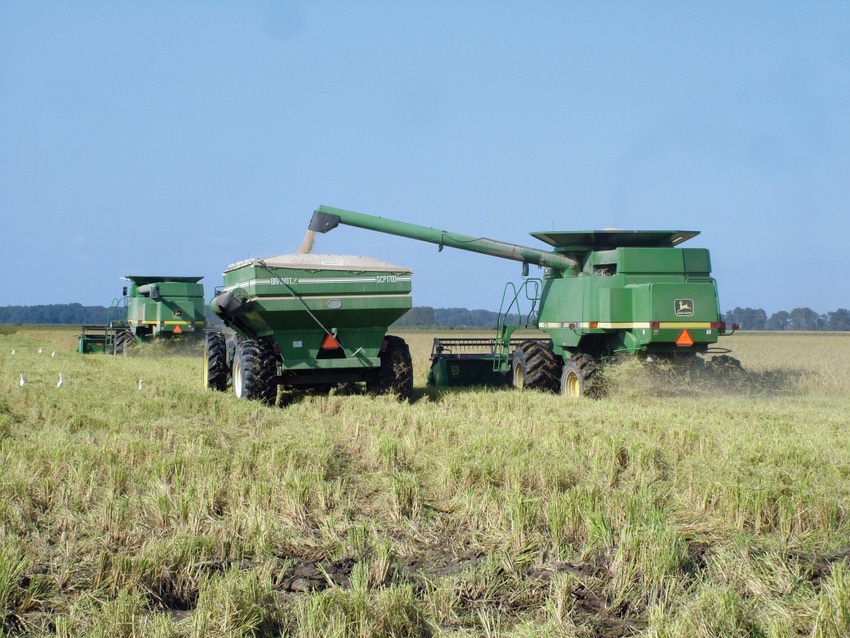
Lower rice and higher corn and soybean prices are causing Arkansas producers to consider reducing rice plantings next spring.Corn, soybean and wheat prices could go higher before going lower, according to University of Arkansas Extension economist Robert Coats.Nevertheless, rice returns could compare favorably with returns for corn and soybeans under certain price scenarios.
December 12, 2012

Arkansas producers could decrease their rice acres in favor of corn or soybeans in 2013 if prices for the latter continue to remain at or near their currently high levels, an Arkansas Extension agricultural economist predicts.
Relatively “low” rice prices compared to corn and soybeans could lead Arkansas growers to seed and harvest 1,120,000 acres of rice in 2013, a decrease of 162,000 acres from 2012’s harvested acreage, says Robert Coats, professor of economics at the University of Arkansas.
Dr. Coats’ forecast includes 1,020,000 acres of long grain (compared to 1,170,000 in 2012) and 97,000 acres of medium grain rice (compared to 109,000 acres in 2012 and 243,000 acres in 2011). His comments came during a presentation at the USA Rice Outlook Conference in San Diego on Monday (Dec. 10).
“U.S. policies and global food security concerns are distorting the rice/corn price relationship,” says Coats. “The same is true with rice/soybeans.”
Several countries have increased their rice production in recent years due to the food shortages and high rice prices that caught the world’s attention in 2008. As a result, world rice production has exceeded consumption in five of the last six marketing years.
2012-13 consumption up
In 2012-2013, however, world rice milled consumption reached 467.9 million metrics tons compared to world rice milled production of 464.3 million metric tons. Production was down slightly from 2011-12, while consumption was up 10 million metrics tons from 2011-12.
World rice prices, meanwhile, are being constrained by the stocks that have accumulated while rice-consuming countries, such as India increased their grain production in response to the 2008 food crises.
“The gap between U.S. and Indian export quotes widened $10 in the past month to $175, a major increase since February when the spread was only $60,” says Coats. “Top exporter India continues to sell its massive stocks while the U.S. faces a relatively small rice crop and near-record prices for other grains.”
The stocks situation has helped create a two-tier price system with quotes from Thailand and South America joining the U.S. to form the higher-priced tier while Vietnamese and Pakistani quotes are closer to India.
World rice ending stocks appear to be consolidating and are expected to decline from 105.8 million metric tons for 2011-12 to 102.3 million metric tons for 2012-13 as demand for rice increases. But the 2012-13 total is still the highest ending rice stocks figure since 2002-03.
U.S. farm programs also appear to favor other grains more than rice.
Still, Coats says it’s possible for rice producers to have favorable returns to operating costs depending on how prices for the various commodities rise or fall over the next few months.
Narrow range
Coats believe futures prices of the major commodities will trade in a relatively narrow channel in 2013 with corn rising as high as $8.50 on the upside and falling to as low as $6.00 on the downside.
Wheat could trade between $6.50 and $9.50, soybeans between $13.00 and $17.50 and rice between $6.30 per bushel or $14 per hundredweight and $8.78 per bushel or $19.50 per hundredweight.
While most growers seem to be favoring corn or soybeans in their current plans for 2013, Coats showed how a $1 change in the price of either commodity can have a major impact on a producer’s return to operating costs.
With corn yielding 175 bushels per acre, for example, a grower’s net return to operating costs for $6.50-per-bushel corn would be $532 per acre and for $7.50-per-bushel corn, $708 per acre. A rice farmer with a yield of 190 bushels per acre, on the other hand, could receive $678 per acre for rice sold at $6.98 per bushel and $764 for rice priced at $7.43 per bushel.
For soybeans yielding 50 bushels per acre, the return for soybeans sold at $13 per acre would be $305 per acre and for beans sold at $15.00 per bushel, the return to operating costs would be $405 per acre. For higher yielding rice – 210 bushels per acre in his example – the returns could range from $742 to $836 per acre.
Rice specialists from other states said they also expected declines in their growers’ acreages with the exception of Texas where farmers could increase their plantings from 2012’s 132,000 to 160,000 if more irrigation water is available from the Lower Colorado River Authority.
Some observers are predicting Mississippi’s rice acres could drop as low as 125,000 due to shifts in that state to corn and lower rice prices.
About the Author(s)
You May Also Like





